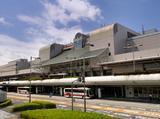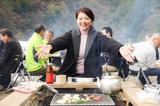
西村 愛
2004年からスタートしたブログ「じぶん日記」管理者。47都道府県を踏破し、地域の文化や歴史が大好きなライター。
島根「地理・地名・地図」の謎 (実業之日本社)、わたしのまちが「日本一」事典 (PHP研究所)、ねこねこ日本史でわかる都道府県(実業之日本社)を執筆。 サントリーグルメガイド公式ブロガー、Retty公式トップユーザー、エキサイト公式プラチナブロガー。

「アサヒビール大山崎山荘美術館」の庭園美、建築美を堪能する
阪急電車大山崎駅やJR山崎駅などから徒歩圏内の美術館を訪ねます。
「アサヒビール大山崎山荘美術館」は、元は関西の実業家であった加賀正太郎の山荘です。
加賀は、遊学先のイギリスで見たテムズ川の景色に、大山崎近くで合流し淀川となる木津川、宇治川、桂川の景色を重ね合わせ、この地を山荘建設の場所に選定。20年の歳月をかけ、建築家に委ねることなく自らが設計、デザインを手がけた建物や庭園などを建設しました。
四季を感じる樹木や花々が植えられた洋風庭園と池を有する和風庭園が、チューダーゴシック様式のモダンな建物と見事なコントラストを描き、和洋折衷のエレガントな景色が5,500坪の敷地内いっぱいに広がります。
加賀の山荘には数々の銘木が使われており、時代を経て趣ある深い艶と美しい木目が浮き出る、上質感漂う内装で彩られています。その中でも展示室の折上天井にある「たけのこ」の彫刻は必見。この地域の特産品を見過ごすくらいさりげなく配置し、気づいた来客を楽しませる遊び心が見え隠れします。また、天井からシャンデリアが下がり吹き抜けになった階段室の豪華さは、誰もが息をのむ美しさ。ひとつひとつにこだわりと建築にかける熱意を感じ、センスの良さが光っています。
この建物は歴史の中で老朽化し、昭和の終わりにはマンション計画により取り壊しの危機に瀕したこともありました。しかし、地元有志らによる保存運動などが行われた末に、加賀正太郎と縁のあったアサヒビールが京都府と共同で購入、復元し美術館として公開、昨年には25周年を迎えました。
100年以上が経過し、登録有形文化財としての建築的価値がある山荘と共に、民藝運動ゆかりの品やモネなどの常設展示を鑑賞できます。喫茶室からの眺望も良く、安藤忠雄設計「地中の宝石箱」「夢の箱」など現代建築も見ることができるのが特徴的です。
アートと建築、豊かな自然を満喫できる、魅力たっぷりの美術館でした。

「アサヒビール大山崎山荘美術館」でアート旅を楽しみます。

建築、庭だけでなくロケーションも最高の、風情感じる美術館です。

庭を抜け、正面に見えるのは元車庫のレストハウス。

四季を感じる立体感ある庭園と優美な三連アーチ。

天王山を借景として、緑深い魅力的な景観を生み出しています。

豪華な階段室。深い艶を有する建材とステンドグラス。

展示室上部にある「たけのこ」彫刻。加賀正太郎の乙訓エリアの名物を建物に刻み付ける遊び心。

切り子になった窓ガラス。

ガラスの屈折によりレインボーの光が差し込む。

喫茶室から見える景色。加賀正太郎はこの景色を見てこの場所に山荘を建てることを決めた。
アサヒビール大山崎山荘美術館
| 住所 | : | 京都府乙訓郡大山崎町銭原5-3 |
|---|---|---|
| 電話 | : | 075-957-3123(総合案内) |
| 開館時間 | : | 10:00~17:00(入館は16:30まで) |
| 休館日 | : | 月曜日(祝日の場合は翌火曜、臨時休館はHP参照) |
| URL | : | https://www.asahibeer-oyamazaki.com/ ※館内は撮影禁止 |
丁寧な暮らしを提案する「Relish」「レリッシュ食堂」
駅近くの民家に並び、おしゃれな外観の平屋の一戸建てが目に留まります。
ここは、森かおるさんが主宰する料理教室と雑貨店「Relish」。住宅だった一軒家をリフォームし、優しい空間広がるレッスンルームと、暮らしの中で使える食器や調理器具、調味料などが並ぶショップからなるお店です。
料理のプロが選ぶ小物やキッチン用品は、すぐにでも使いたくなるものばかり。また、森さんが料理教室の中でも使う京都老舗の出汁や醤油、オーガニック食品なども手に入ります。
店の裏庭は畑になっていて、料理教室などではここで育った野菜も使われます。
「おいしいものを作って“おいしい”と言ってもらう」という、一見単純に見えることも毎日になると大変で、ついついスーパーのお惣菜やデリバリーで済ましてしまう…、ということは誰にでもあること。森さんは、そういった生活スタイルも受け入れた上で、毎日のごはん作りのハードルを下げ、おいしいものを「楽しく」作るヒントを散りばめた料理教室を開催しています。特別でない、日本に当たり前のようにあった食卓に並ぶケの日料理こそが「家庭の味」で、この味わいが家族の想い出やコミュニケーションを作り残していくものだと感じて、教室や講座、イベントで伝えていっています。森さんの活動はさらに広がり、子どもの食育や安全な食への取り組み、食文化そのものの継承も行っているということです。
そんな森さんのお料理を食べられるのが、Relishから徒歩10分程度の場所にある「レリッシュ食堂」。
毎月かわる定食には、森さんが提案するメソッドが詰め込まれています。定食には見た目も良く、上品ながらも五味のバランスがとれたおかずが並び、時には、Relishの畑で育ったハーブや葉物野菜なども使われます。また、京都の老舗「うね乃」の出汁を使ったお味噌汁、森さん自家製のぬか漬けなど、ちょっとしたコツや知識でおいしくなる料理のヒントがたっぷりと盛り込まれていました。
この日のメインはチーズインハンバーグ。ソースまで手作りで、それらのレシピはすべて黒板に公開。家に帰ってからも再現、チャレンジしやすいレシピ、メニューとなっています。
食事は胃袋だけでなく、心を満たすもの。日々の食生活から、心満たされる体験を積み重ねることで、生きるパワーや豊かな感性が育っていく。そして料理は、ちょっとした工夫でおいしくもなり、楽にもなり、楽しくなる。
Relishからたくさんのことを教わった、有意義な時間。
改めて、京都の食の奥深さを知った体験にもなりました。

大山崎町にある「Relish」。庭付き一軒家の料理教室&雑貨店。

日常使いしやすい食器や調理器具などが並びます。

料理研究家・森かおるさんがセレクトした調味料や出汁も購入できます。

裏庭にある野菜畑。収穫した野菜は、料理教室や食堂の料理に使われます。

「レリッシュ食堂」の月イチで変わる定食。

この日のメニューのレシピが公開。

この日の定食、野菜たっぷり。

メインはチーズハンバーグ。

中からチーズがとろっとあふれ出します。

Relishとレリッシュ食堂は徒歩10分ほどです。
Relish
| 住所 | : | 京都府乙訓郡大山崎町大山崎竜光49 |
|---|---|---|
| 電話 | : | 075-953-1292 |
| 営業時間 | : | 10:30~17:00 |
| 定休日 | : | 月曜日(月曜祝日の場合は営業・翌火休み、10日は営業)、夏季、冬季休業あり |
| URL | : | https://www.relish-style.com/ |
レリッシュ食堂
| 住所 | : | 京都府乙訓郡大山崎町大山崎鏡田20-14-1F |
|---|---|---|
| 電話 | : | 080-2522-4468 |
| 営業時間 | : | 11:00~15:30 |
| 定休日 | : | 日曜日、月曜日(月曜祝日の場合は営業、翌火休、10日営業の場合あり)第2火曜日、夏季、冬季休業あり |
| URL | : | https://www.relish-style.com/ |
「柳谷観音 楊谷寺」の花手水に癒される
神社や寺の境内にある手水舎。主にはお清めをする際に使うものですが、最近そこに美しく花を浮かべた「花手水」というものがあるのをご存じでしょうか。
この花手水で、お参りに来る人たちの目を楽しませているのがここ「柳谷観音 楊谷寺(以下、楊谷寺)」です。
楊谷寺は806(大同元)年に開山したと伝えられ、1200年以上の歴史がある山あいに建つ古寺です。登録有形文化財の本堂や、江戸時代中期に作庭された京都府指定名勝に数えられる庭園を持ち、眼病平癒の観音様として親しまれています。また、あじさいや紅葉の季節は特に人気が高く、多くの人が訪れるお寺です。
ここで、毎日手水に草花を生けているのがご住職とその奥様。庭に花木を植えたいと思ってはみたものの、名勝に指定されていることから植栽にも様々な制約があり、思いあぐねた末にふと思いつきで手水の中に花を浮かべてみたのが始まり。2018年にSNS上で人気に火が付き、それ以来、境内の手水に様々な季節の花を浮かべています。心癒してくれる花は世界中の人へのメッセージで、これを発信することで小さな平安を感じてほしいとの想いが込められています。
一滴の雨粒でも崩れてしまう花手水。ご夫婦で1日うちでも何度も手入れをしながらになるので時間を要するものですが、お参りに来る人たちに喜んでもらえるよう、工夫しながら製作しているそう。
寺の伝統は守りつつ小さな変革を加えた寺は、日本中から観光客が足を運ぶ乙訓エリアを代表する人気スポットとなっています。

「柳谷観音 楊谷寺」。花手水が有名なお寺です。

山懐に抱かれた、古社です。

京都府指定文化財の本堂。

京都府指定名勝の庭園「浄土苑」。

境内の手水鉢に、さりげなく控えめな冬の装い。

庭の花木(ここでは千両)などを利用して生けられています。

季節感を感じさせる花々が魅力的に飾りつけられます。

境内あちこちに点在する花手水を探してみるのも楽しいです。

龍手水にもポインセチアが生けられていました。

ハートの写真スポットもあり、想い出をカメラに残せます。

笑顔のお地蔵さんや自然に溢れた境内に心安らぎます。
柳谷観音 楊谷寺
| 住所 | : | 京都府長岡京市浄土谷堂ノ谷2 |
|---|---|---|
| 電話 | : | 075-956-0017 |
| URL | : | https://yanagidani.jp/ |
歴史と食の文化を楽しむ和食店「おばんざいとお酒 なかの邸」
長岡京市、旧西国街道沿いにある江戸末期に建てられた文化財「中野家住宅」。国登録有形文化財に登録された建物で、当時の町屋の特徴をたっぷりと含み持つ歴史的建造物です。
2014年に市に寄贈された建物はその後、障がい者支援団体「一般社団法人 暮らしランプ」によって運営される、飲食店「おばんざいとお酒 なかの邸(以下、なかの邸)」へと生まれ変わりました。飲食店としてだけではなく、京都の大工棟梁が手掛けた「皎庵(こうあん)」、藍染めなどの体験施設として利用される予定の土蔵、新たに付け加えられた竹垣など、見所多いスポットです。
障がい者でも楽しみながら働ける場づくりが行われる「なかの邸」。この空間にどう料理を合わせるか。試行錯誤を繰り返しながら3年目を迎え、地元だけでなく観光客も訪れるお店に成長しています。
素材の味を大切に、出汁を効かせた体にじんわりと染み入る料理がコースで提供されます。
夜のメニュー「なかの邸コース」は、おばんざい5種に熟成ローストビーフ、季節のメイン料理、一刻干し、釜めし(お出汁付)。味のバリエーションも良く上品な出汁の優しい風味で、最後まで楽しみながら食べ進められました。建物内にはコーヒー焙煎機もあり、こだわりの一杯を食後に楽しめます。
特に「一刻干し」は京都・宮津の名物で、新鮮な魚をさばき、その後1.5時間~2時間程度干すことにより水分を抜き、旨味を凝縮させる調理方法です。保存のためというよりもむしろ、しっかりとした味と食感を生み出すための手法で、焼いた後はジューシーさも残っています。
コースはおばんざいやお出汁などと共に日本の食文化を盛り込んだ構成で、愉しみながら味わえる内容でした。
ランチタイムは仕出し弁当スタイル営業もやっています。

歴史を感じる上質空間で夕食を。

乙訓エリアは西国街道が横断する地区でもあります。

街道沿いに建つ「中野家住宅」。主屋は国登録有形文化財。

新たに設置された竹垣は立命館高校の学生がデザインを担当、長岡銘竹が製作。

福祉施設として、新しい雇用を生み出す仕組みを用いた自家焙煎コーヒーを販売。

お庭が見える席で料理をいただきます。京都老舗「うね乃」の出汁を使った、五味五感を楽しめる5種類。

旨出汁を特に感じられるのがきのこあんの茶碗蒸し。

エイジングをかけ、旨味を凝縮したローストビーフ。

優しい味わいが具材の奥までしみ込んだ、おでん。

一刻干しは味の凝縮とジューシーさを兼ね備えたいいとこ取り。

目の前で炊きあがる釜めし。

最後も“おだし”。出汁茶漬けでサラリとシメました。
おばんざいとお酒 なかの邸
| 住所 | : | 京都府長岡京市調子1-6-35 |
|---|---|---|
| 電話 | : | 075-959-2877 |
| 営業時間 | : | 11:30~15:00、18:00~22:00 |
| 定休日 | : | 日曜日、月曜日 |
| URL | : | https://www.instagram.com/kurashilamp_nakanotei (Instagram) |
掲載の内容は記事公開時点のもので、変更される場合があります。











